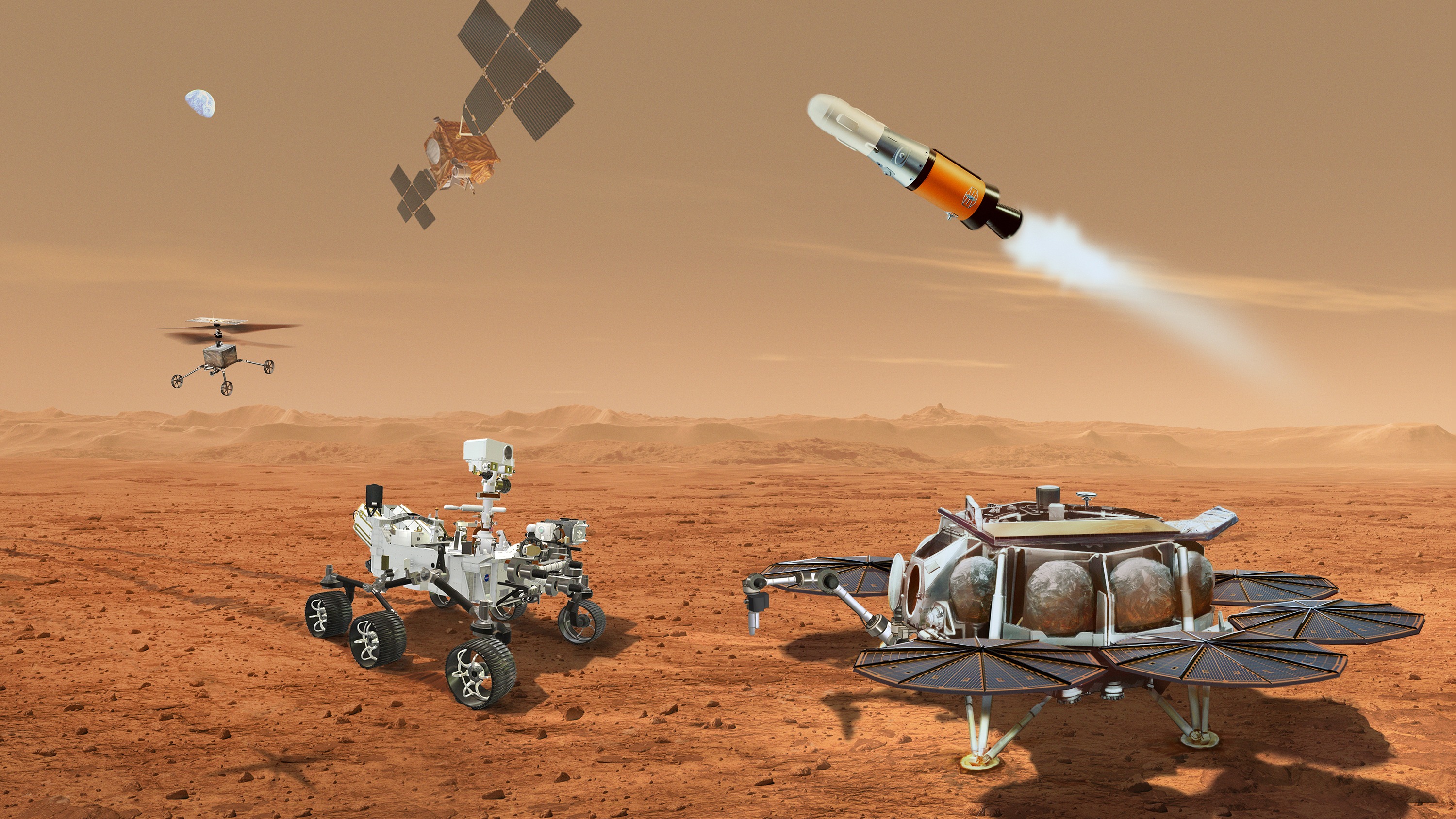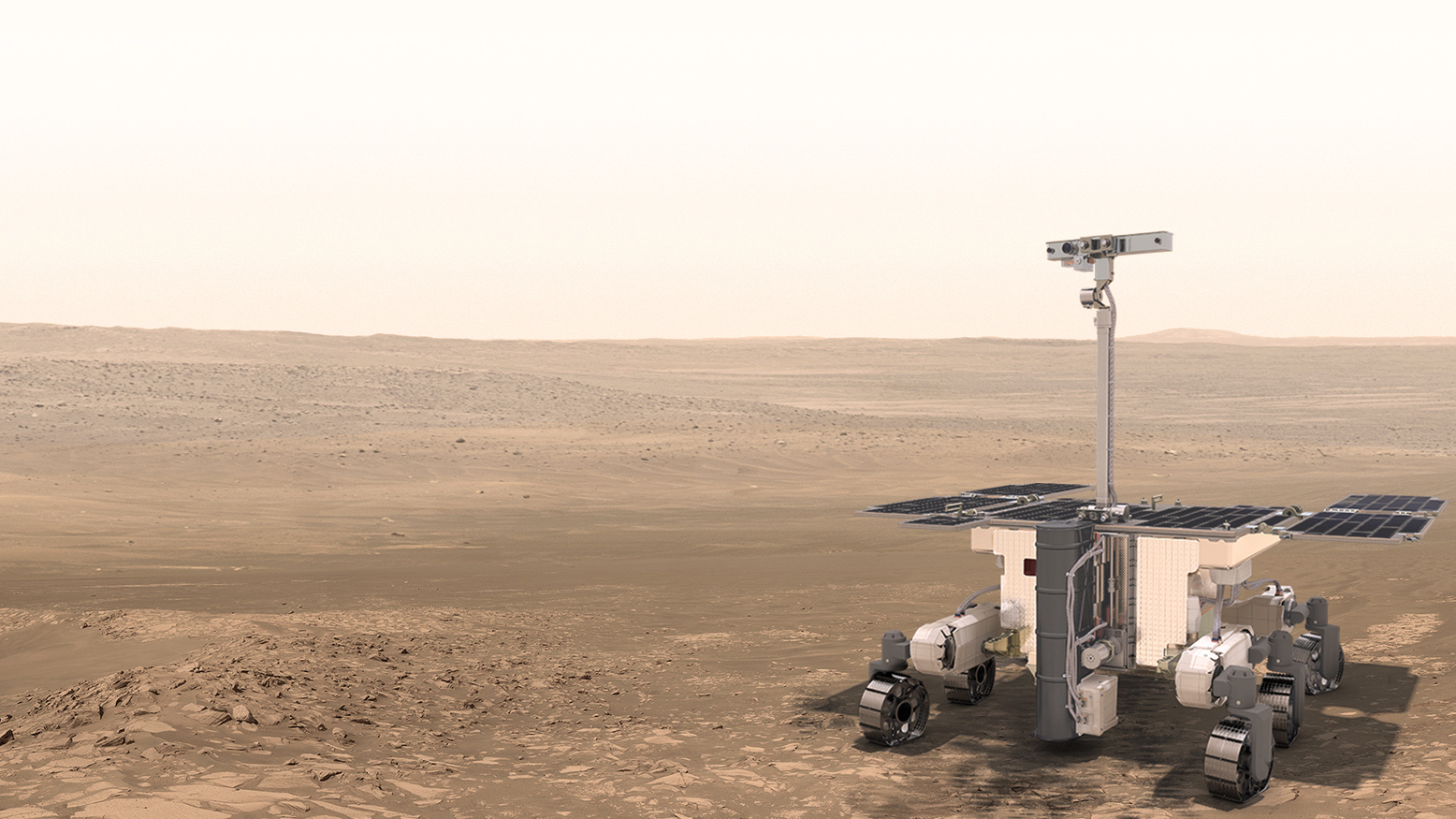Mars sample return mission adds 2 helicopters, scraps 'fetch' rover

The campaign to bring pristine Martian samples to Earth will now include two mini helicopters.
NASA officials involved with the Mars sample return (MSR) effort announced today (July 27) that they plan to redesign the mission, abandoning a previous concept that called for a European Space Agency (ESA) "fetch rover" that would touch down on its own lander.
NASA's Perseverance rover, expected to still be active when a NASA MSR lander touches down in 2031, will now be tasked with bringing the samples it is collecting and caching to a Mars ascent vehicle. Failing that, however, two helicopters much like Ingenuity, which landed with Perseverance last year, will be backup options to pick up the caches themselves.
The helicopters will be similar to Ingenuity in terms of size and mass, but with two key differences, NASA MSR program manager Richard Cook told reporters during a briefing today.
"There will be landing legs that include, at the bottom of them, mobility wheels," Cook explained, saying this new capability will allow the helicopters to "traverse across the surface." A mini robotic-arm on each of the craft will allow the drones to pick up the sample tubes Perseverance leaves behind, if need be.
Related: 12 amazing photos from the Perseverance rover's 1st year on Mars
If the helicopters are needed for such work, they will land near a sample tube, roll over to pick it up, then fly to a spot near the Mars ascent vehicle. After touchdown, the helicopters will roll closer to the vehicle and drop the sample within reach of a newly announced ESA-built transfer arm.
Breaking space news, the latest updates on rocket launches, skywatching events and more!
The redesign decision means that no ESA rover will touch down on Mars in the near future. But the new concept also may allow NASA and ESA to accomplish the ambitious sample return effort with less cost and complication, according to the coalition.
"The engineer in me was fascinated by the sample rover, because it's designed to travel much faster than previous Mars rovers, probably about four or five times as quickly over the surface," David Parker, director of ESA's human and robotic exploration, told reporters today.
Adding the rover, however, would have entailed "a second launch, second lander and so forth," which meant that removing the hardware from the manifest "makes a great deal of programmatic sense," he said.
ESA is still building a rover tasked with landing on Mars — a life-hunting robot named Rosalind Franklin. That rover was supposed to launch this year on a Russian rocket, but that plan fell through after Russia invaded Ukraine. Rosalind Franklin is now expected to lift off no earlier than 2028.
"The engineering team has been working at great speed to find an alternative approach for delivering Rosalind Franklin rover to Mars," Parker said of the situation, saying different options are under discussion. A special European council meeting in Paris in November will allow member states to decide the best path forward, he added.
Life on Mars: Exploration and evidence

Parts of the revised MSR plan are still being worked out. Officials have no estimate yet on the cost but suggest that only having a single lander going to Mars will be far less costly than sending two. The helicopters also have no defined primary mission, although they may be tasked with observing the area around the Martian ascent vehicle or observing the rocket as it takes off from the Red Planet, Cook said.
This new design was spurred in part by the impressive performance of other hardware that has greatly exceeded its lifespan on the Red Planet, said Thomas Zurbuchen, associate administrator of NASA's Science Mission Directorate.
The Curiosity rover, which informed the design of Perseverance, will celebrate 10 years on Mars on Aug. 5. Ingenuity was cleared for a five-flight plan in its design but has flown 29 times on the Red Planet to date.
There's been a lot of movement on the MSR file in recent months. In May, NASA asked the public to provide comments on an environmental assessment as the agency readies for a draft environmental impact statement later in 2022.
The second lander requirement, now dropped, itself was added only in March after the Mars Sample Return Independent Review Board said a dual lander capability "may improve the probability of mission success," according to NASA statements at the time.
But the addition of the second lander forced the mission to push the launch date two years back to 2028, and the takeoff to return to Earth another two years to 2031. (Those timelines haven't changed with the new mission plan.)
NASA also announced during the MSR press conference that the Perseverance rover is in the middle of picking up its 11th sample on the Red Planet. That sample, a fine-grained sedimentary rock, was selected due to its potential in preserving biosignatures that might be key to help scientists assess the chances for life on Mars.
Follow Elizabeth Howell on Twitter @howellspace. Follow us on Twitter @Spacedotcom and on Facebook.

Elizabeth Howell (she/her), Ph.D., was a staff writer in the spaceflight channel between 2022 and 2024 specializing in Canadian space news. She was contributing writer for Space.com for 10 years from 2012 to 2024. Elizabeth's reporting includes multiple exclusives with the White House, leading world coverage about a lost-and-found space tomato on the International Space Station, witnessing five human spaceflight launches on two continents, flying parabolic, working inside a spacesuit, and participating in a simulated Mars mission. Her latest book, "Why Am I Taller?" (ECW Press, 2022) is co-written with astronaut Dave Williams.
